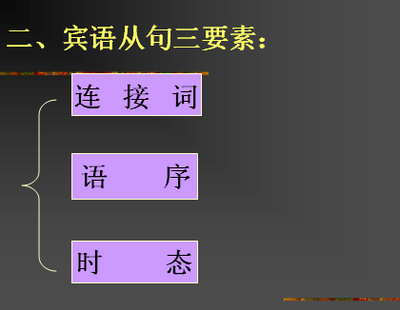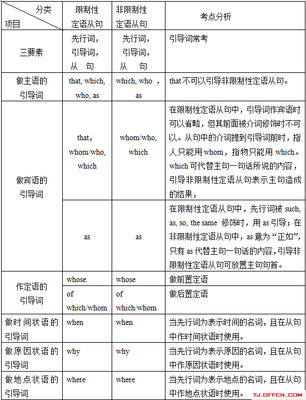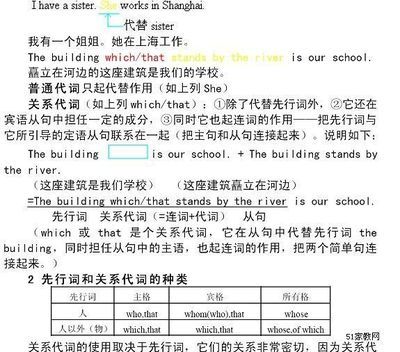there作引导词的句子通常表示某物存在或发生某事,主要由“there +be+名词词组(+修辞语)”等构成。此种结构中,there已经失去了表示场所的意义,不重读,常读作/ZE /。
there be句型的各种谓语表示形式
there 后面的be 除了用is、are、was、were 外,还可以用包含be 的各种谓语表示形式。常见的“there+助动词+be”的形式如下:
--there will/would be… 将有……
--there can/could be… 能有……
--there must be… 一定有……
--there must have been… 一定有了……
--there may/might be… 可能有……
--there may have been… 可能已经有……
--there should be… 应该有……
--there should have been… 本来应该有……
--there ought to be… 应当有……
--there has/have/had been… 已经有……
--there is/was going to be… 将要有……
--there is/was to be… 要有……
--There will be plenty of room for everyone.
--There must be no doubt about this.
--There may be a letter for me.
--There is going to be athunderstorm.
动词要与主语在数上相一致
a. there be 句型中be 后面的主语是复数时,动词be 也相应用复数形式。--There are two mistakes in the translation.
--There were hundreds of people on the beach.
b. 有两个或更多的主语时,如果第一项是单数或不可数名词,则be 要用单数形式。
--There was a sofa and two chairsbesidethe wall.
--There was anger in his eyes and reproach at the unfairness of it all. (对于这种不公正,他的眼里显示出愤怒和谴责)
c. 表示数目的词语,如“a hundred” “a thousand” “a million”和“a dozen”等,尽管前面有“a” be 也要用复数形式。
--There are a hundred reasons why a war may break out between two countries.
--There are a dozen eggs in that basket.
d. 表示复数的数量词,如“a number of”、“a great number of”、“a few of”等,尽管前面有“a”,be 也要用复数形式。
--There have been a number of accidents at that spot.
--There are a few of streams in this district.
e. 主语若是单数集体名词,如 a crowd of people, a gang of thieves, a company of soldiers, a group of boys, a row of houses等,be 要用单数形式。
--There was a crowd of people at the street corner
--Behind there was a row of low houses.
主语的非限定性
a. there be 句型中的主语是非限定性的,不可用the, this, that, these、those等词修饰。例如:--There was a railway accident last night.
-- There was the railway accident last night.
b. 不可用“all/every +名词”作主语。例如:
-- There are all the cows in the field.
-- There was everyone in the waiting room.
只有在回答时才可用everything等。例如:
--What is there to be afraid of?
--There is everything to be afraid of.
但是,在极少数情况下,这种句型中可用限定性主语(专有名词或带the的名词):
1) 在回答表示“存在”的问句时:
--Is there anyone coming to dinner?
--Yes, there is John and there is also Mrs. Smith.
--Have you any loose cash in the house?
--Well, there is the money in the box over there.
2) 当主语被形容词最高级修饰时:
--There was the oddest-looking woman standing at the street corner.
there be 的非谓语形式
a. there to be
“there to be”和“for there to be”是there-句型中的be 采用不定式形式,一般出现在书面语中。“there to be”可用作下列动词的宾语:ask, expect, hate, intend, like, mean, prefer, want等。例如:
--I don’t want there to be anymisunderstanding.
(我不想有任何误解。)
--Would you like there to be a meeting to discuss the problem?
当there to be 用作主语时,前面要带for。例如:
--For there to be so few people in the street was unusual. (=It was unusual for there to be so few people in the street.) (街上这么少人,这是不常有的事。)
b. there being
“there being”是指there-句型中的be采用动词-ing形式,也属书面语,可以用作介词宾语和状语。
--He was disappointed at there being so little to do.
--There being no further business, the chairman closed the meeting. (因为没有别的议程,主席结束了会议。)
注意:在“V.+for”结构中,for后面用there to be 作宾语。例如:
--Jack waited for there to be another opportunity.
there 与形容词连用
there 也可与形容词likely, unlikely,liable, sure, certain, bound, apt, due等连用,表示某事发生的可能性。例如:
--There are unlikely to be (不可能会有……) any problems with thetimetable.
--There is certain to be (一定有……) trouble on the border.
--There is bound to be (一定会有……) a man here soon.
“there be+no…”结构
a. “there be+no+动词-ing形式”表示“不可能……”,相当于“It is impossible…”。例如:
--Once let this fellow start talking, there was no stopping (法停止……) him.
--There was no knowing (法知道……) how long he might be away.
--He’s bad-tempered and selfish, there is no denying it, but he’s also a genius.
--There is no lighting fireworks that day.
常用于此结构的还有there is no telling, there is no arguing, there is no bearing, there is no accounting等。
b. “there be+no+名词”
--There is no need (没有必要……) for you to stay up to let me in ―just lend me a key.
--There is no use (没有用处/好处) our discussing it any further now.
--The thing is done and there is no help for it now. (木已成舟,无可挽回了。)
--There is no sense(没有理由……)(in)waiting here.
“there +V.+to be+名词词组”

这种句型常用来说明某事似乎是这种情况或似乎已经发生过。常见的动词有appear, seem, happen, tend, continue等。
--There appears to have been (似乎有……) a misunderstanding.
--There seems to be (似乎有……) something the matter with her.
--There happened to be (碰巧有……) atypewriterin the room. I used it to type two envelopes.
有时,尤其在不可数名词前,“to be”可以省略。例如:
--There seemed little or no prospect of John’s success.
“there+v.+名词词组”
这一句型常用于说明某事的发生和存在,仅出现在正式英语或文学作品中。句意的重点在主语部分,不在动词。句中的动词必须是不及物动词,常见的是:
a. 表示运动的动词有come, follow, pass, arrive, enter等。例如:
--There comes a time when you have to make a choice.
--There followed anavalancheof protests after it was rumoured that the rate of income tax would be raised.(有谣传说所得税税率将要上涨,这引起了人们强烈的抗议。)
b. 表示出现的动词有occur, spring up, appear,emerge, arise等。例如:
--Not long after this, there occurred a sudden revolution in public taste. (此后不久,公众的口味突然发生了巨大的变化。)
--Theresprangup a wild gale that night.
c. 表示静止的动词有exist, remain, stand, live, lie等。例如:
--There exist different opinions on this question.
--There remained a still more difficult and dangerous task.
--At the top of the hill there stands the old church.
间或还可见到动词词组也用于这一句型:
--There took place an elaborate ceremony in honour of some distinguished guests.
there 引导的句型的其他问题
a. 与“there”连用的缩略式
在口语及非正式书面语中,“there is”、“there has”常常缩略为“there’s”;“there had”、“there would” 常缩略为“there’d”;“there will”常缩略为“there’ll”。
--There’s someone on the phone for you.
--I didn’t even know there’d been a murder.
--There’ll be trouble at the match.
b. “there+be+名词词组(+修辞词)”用作形容词从句
--I must make full use of the time there is left to me and do as much as I can for the people.
(我要充分利用剩下的岁月尽量为人民多做些事。)
--We try to make a list of all the books (that) there are on the subject. (我们设法把所有关于这个题目的书列出一个单子。)
c. there引导的句型的被动式
这一用法只限于极少数动词,如:expect, say, believe, think, hope, consider, intend, mean, understand等,用来表示人们说或认为某事存在。
--There is expected to be (预计有……) a broadcast by the president this evening.
--There is said to be (据说有……) oil under the North Sea.
--There is believed to be (据信有……) a desire in both nations to avoid a major conflict.
--There is thought (据认为……) that the football match will start soon.
间或还可见到这样的被动结构:
--On the following day, there was held a splendid banquet.
(次日举行了场面盛大的宴会。)
there be 句型_there句型 -there 引导的句型主语的修辞词
there be+名词词组+形容词
--There are no other jobs available.
--There were several students ill.
--There’s a train due to arrive.
there be+名词词组+介词短语
--There are many theories about the origin of life.
--Is there any other business for the committee at this meeting?
there be+名词词组+不定式
用不定式修辞主语时,既可用主动式,也可用被动式,不定式所表示的动作一般发生在将来。
--There is no time to lose( to be lost).
--There are still many things to take care of (to be taken care of).
在口语中用主动形式更多一些,但有时两种形式可能表示不同的意思。例如:
--There is nothing to do now. (We have nothing to do now.) (现在没事儿干。)
--There is nothing to be done now. (We can do nothing now.) (现在没什么办法。)
--There is nothing to see (nothing worth seeing). (没有东西值得看。)
--There is nothing to be seen (nothing there at all). (看不见有什么东西。)
there be+名词词组+动词-ing形式
动词-ing形式表示动作正在进行,是经常性的动作或是现在存在的状态。
--There were a dozen hungry people standing in the rain.
--There is a house facing the south in the sands.
--There are plenty of people getting promotion. (有许多人晋级。)
there be+名词词组+动词-ed形式
动词-ed形式一般表示被动的动作,发生在谓语动词之前的动作。
--There’ll still be some shops left open. (还会有一些店没关门。)
--There were twenty passengers wounded in the accident.
--There’s been a whole box stolen.
there be +名词词组+形容词从句
--There are some planets that were discovered by the ancients.
--At one time there were houses where that large factory now stands.
--There are some people (that) I’d like you to meet.
there be + 名词词组+同位语从句
--There was no doubt that he was a fine scholar.
--There is no probability that he willdefeathis opponent in the election.
--There is an old saying that in politics the unexpected always happens.
there be 句型_there句型 -含there be结构的几类重要句式
一、There is no / some / much / little difficulty / trouble with sth. 做某事(没) 有困难
(1) There is some difficulty with the text. 这篇课文还有点困难。
(2) There is little trouble with the matter. 这件事情没有什么麻烦。
二、There is no / some / little / much difficulty / trouble in + doing. 做某事有困难
(1) There is much difficulty in finishing the work in the given time. 在规定的时间内完成这项工作还很困难。
(2) There is no trouble in reading the article without a dictionary. 即使不用词典读这篇文章也不难。
三、There is no doubt about / of sth. 毫无疑问……
(1) There is no doubt about his coming here. 毫无疑问,他会来。
(2) There is no doubt of his words. 对他的话毋庸置疑。
四、There is no doubt that
 爱华网
爱华网



